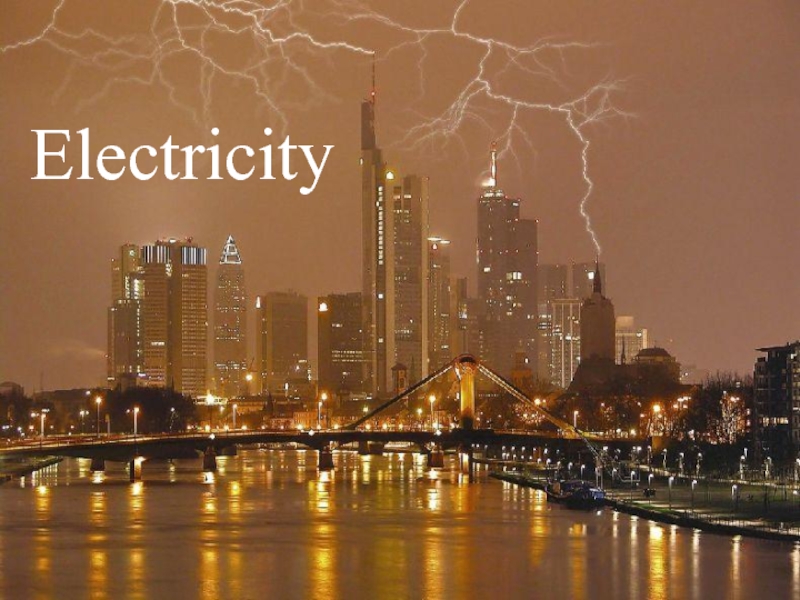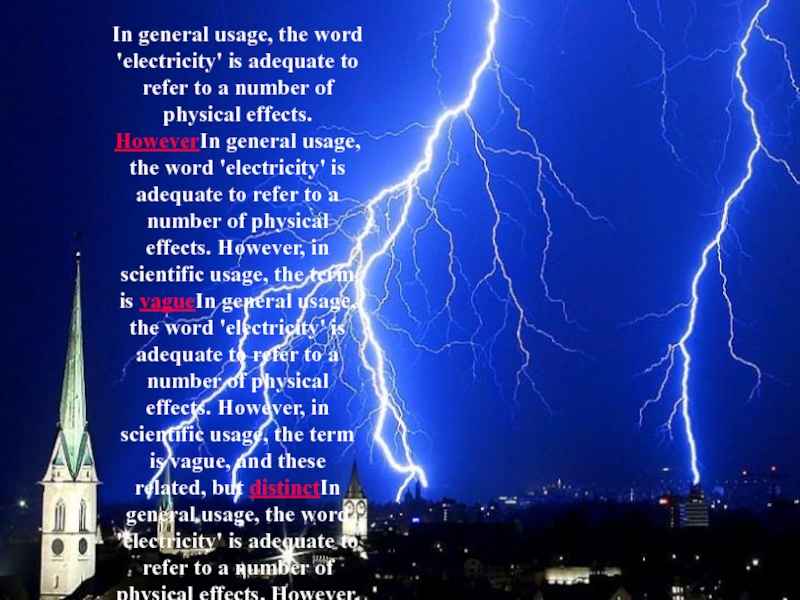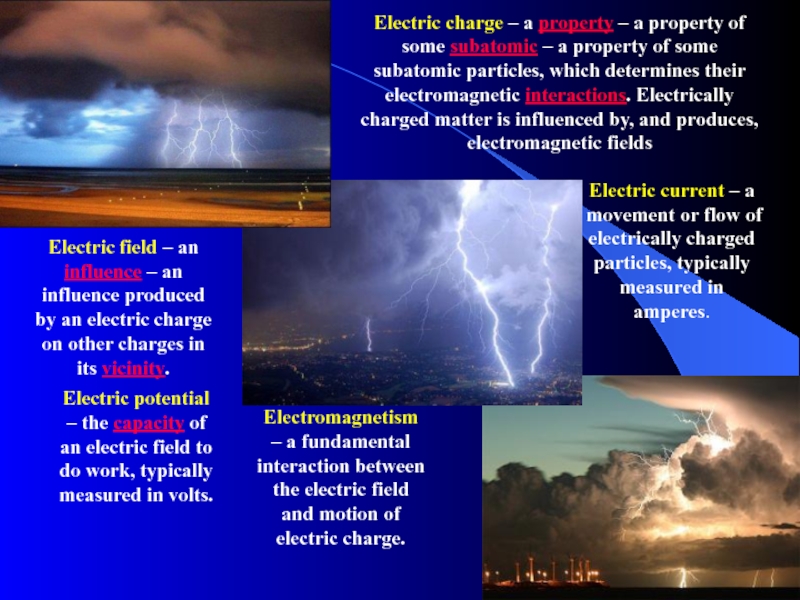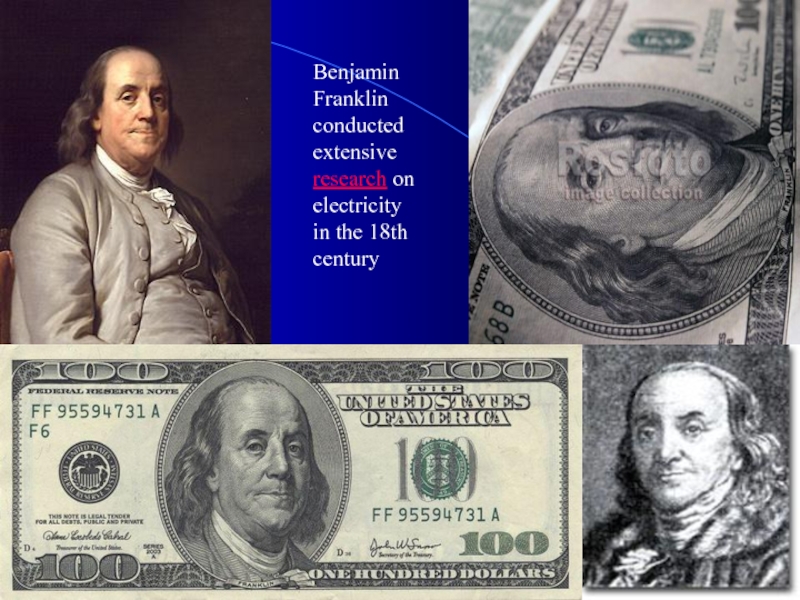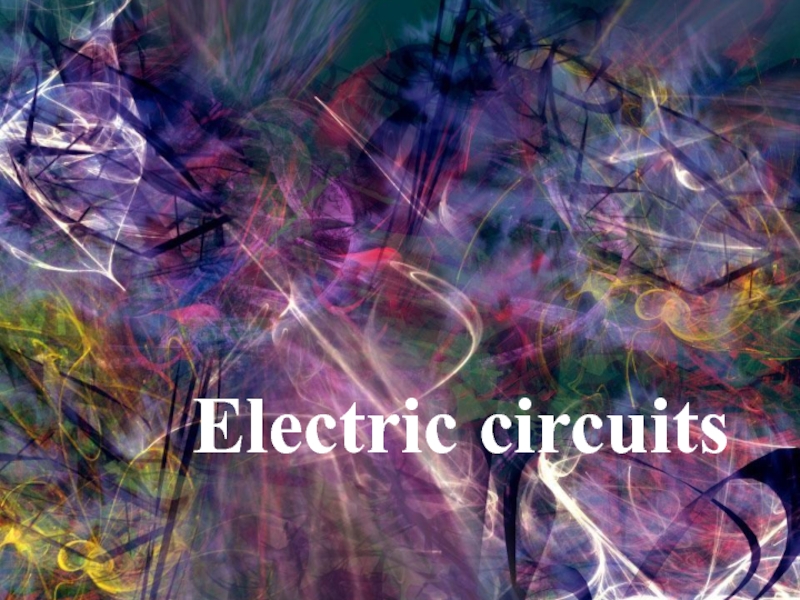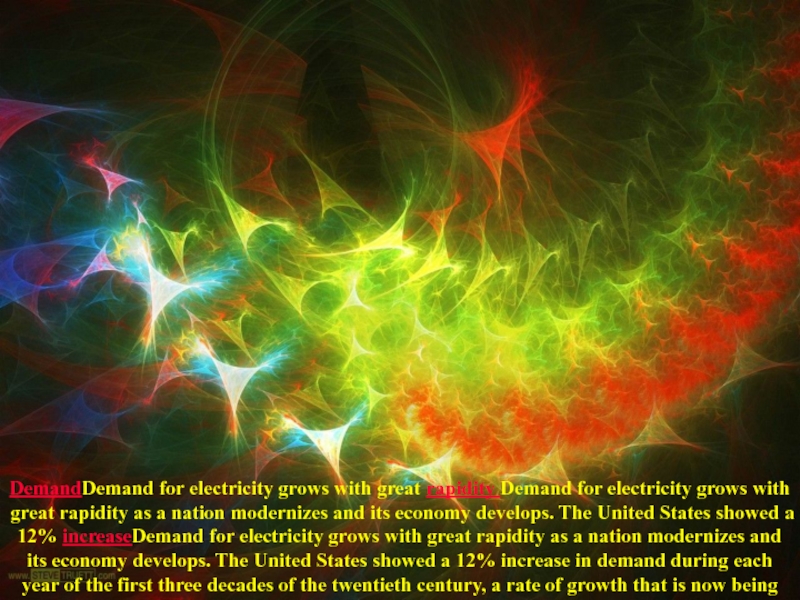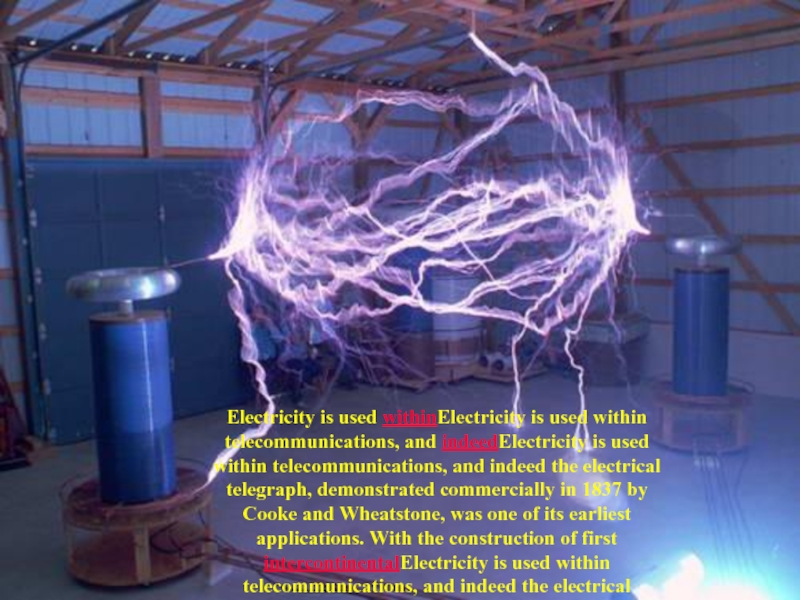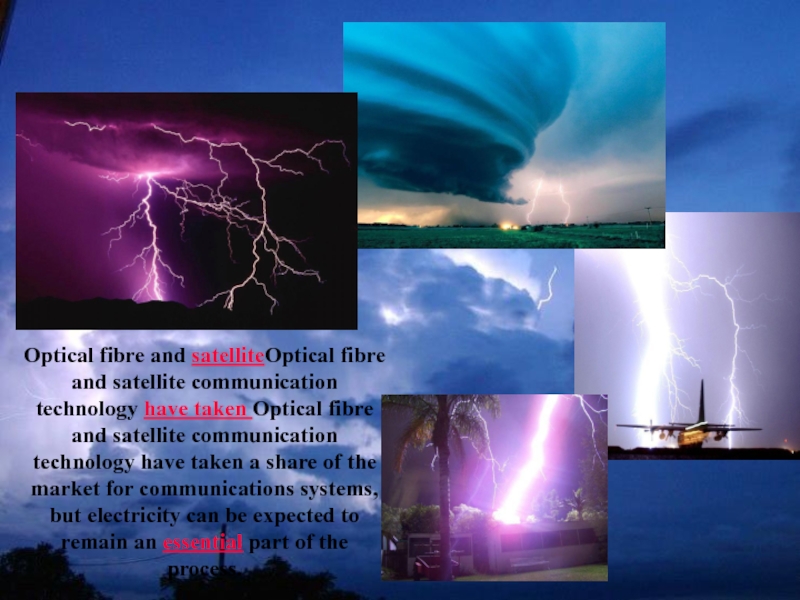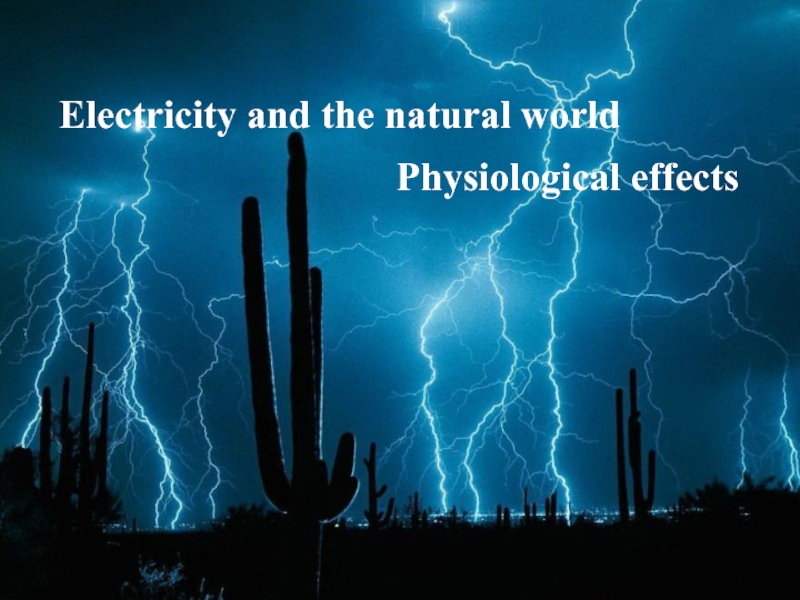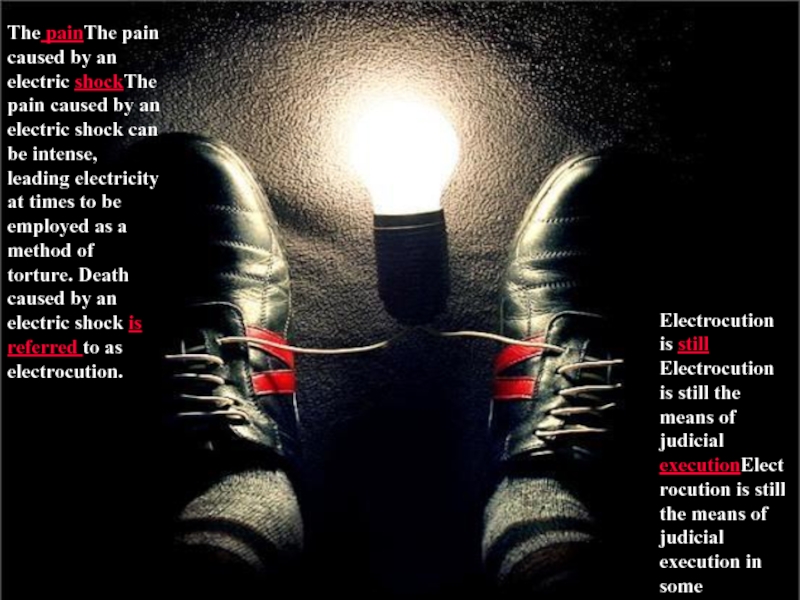Слайд 2References:
Jones, D.A., "Electrical engineering: the backbone of society", Proceedings of the
IEE: Science, Measurement and Technology 138 (1): 1–10
Moller, Peter (December 1991), "Review: Electric Fish", BioScience 41 (11): 794–6 [794]
Bullock, Theodore H. (2005), Electroreception, Springer, pp. 5–7, ISBN 0387231927
Morris, Simon C. (2003), Life's Solution: Inevitable Humans in a Lonely Universe, Cambridge University Press, pp. 182–185, ISBN 0521827043
The Encyclopedia AmericanaThe Encyclopedia Americana; a library of universal knowledge (1918), New York: Encyclopedia Americana Corp
Stewart, Joseph (2001), Intermediate Electromagnetic Theory, World Scientific, p. 50, ISBN 9-8102-4471-1
Simpson, Brian (2003), Electrical Stimulation and the Relief of Pain, Elsevier Health Sciences, pp. 6–7, ISBN 0-4445-1258-6
Frood, Arran (27 FebruaryFrood, Arran (27 February 2003Frood, Arran (27 February 2003), Riddle of 'Baghdad's batteries'Frood, Arran (27 February 2003), Riddle of 'Baghdad's batteries', BBC, http://news.bbc.co.uk/1/hi/sci/tech/2804257.stm, retrieved on 2008-02-16
Baigrie, Brian (2006), Electricity and Magnetism: A Historical Perspective, Greenwood Press, pp. 7–8, ISBN 0-3133-3358-0
Chalmers, Gordon (1937), "The Lodestone and the Understanding of Matter in Seventeenth Century England", Philosophy of Science 4 (1): 75–95
Srodes, James (2002), Franklin: The Essential Founding Father, Regnery Publishing, pp. 92–94, ISBN 0895261634 It is uncertain if Franklin personally carried out this experiment, but it is popularly attributed to him.
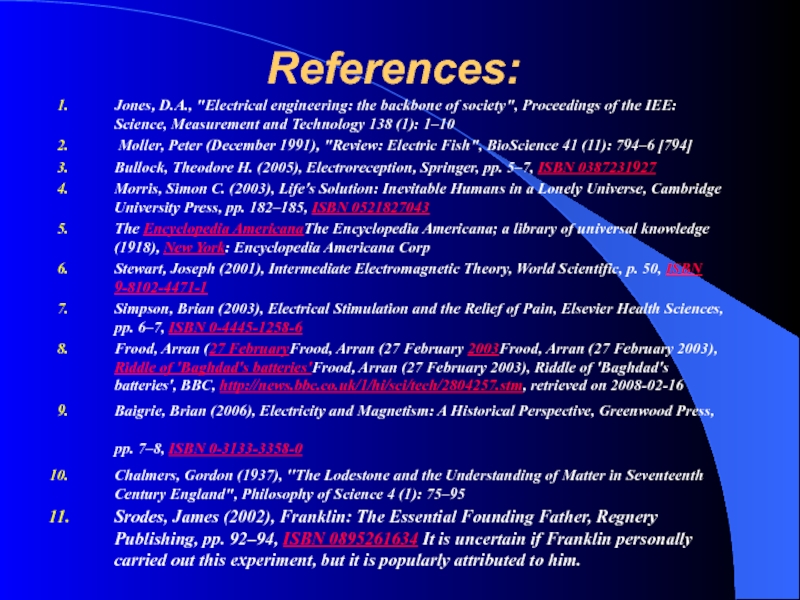
Слайд 3Uman, MartinUman, Martin (1987) (PDF). All About LightningUman, Martin (1987) (PDF).
All About Lightning. Dover Publications. ISBN 048625237XUman, Martin (1987) (PDF). All About Lightning. Dover Publications. ISBN 048625237X. http://ira.usf.edu/CAM/exhibitions/1998_12_McCollum/supplemental_didactics/23.Uman1.pdf
Kirby, Richard S. (1990), Engineering in History, Courier Dover Publications, pp. 331–333, ISBN 0486264122
Marković, Dragana, The Second Industrial Revolution Marković, Dragana, The Second Industrial Revolution, http://www.b92.net/eng/special/tesla/life.php?nav_id=36502, retrieved on 2007-12-09
Trefil, James (2003), The Nature of Science: An A-Z Guide to the Laws and Principles Governing Our Universe, Houghton Mifflin Books, p. 74, ISBN 0-6183-1938-7
Duffin, W.J. (1980), Electricity and Magnetism, 3rd edition, McGraw-Hill, pp. 2–5, ISBN 007084111X
Sears, et al., Francis (1982), University Physics, Sixth Edition, Addison Wesley, p. 457, ISBN 0-2010-7199-1
"The repulsive force between two small spheres charged with the same type of electricity is inversely proportional to the square of the distance between the centres of the two spheres." Charles-Augustin de Coulomb, Histoire de l'Academie Royal des Sciences, Paris 1785.
Duffin, W.J. (1980), Electricity and Magnetism, 3rd edition, McGraw-Hill, p. 35, ISBN 007084111X
National Research Council (1998), Physics Through the 1990s, National Academies Press, pp. 215–216, ISBN 0309035767
Umashankar, Korada (1989), Introduction to Engineering Electromagnetic Fields, World Scientific, pp. 77–79, ISBN 9971509210
Hawking, Stephen (1988), A Brief History of Time, Bantam Press, p. 77, ISBN 0-553-17521-1
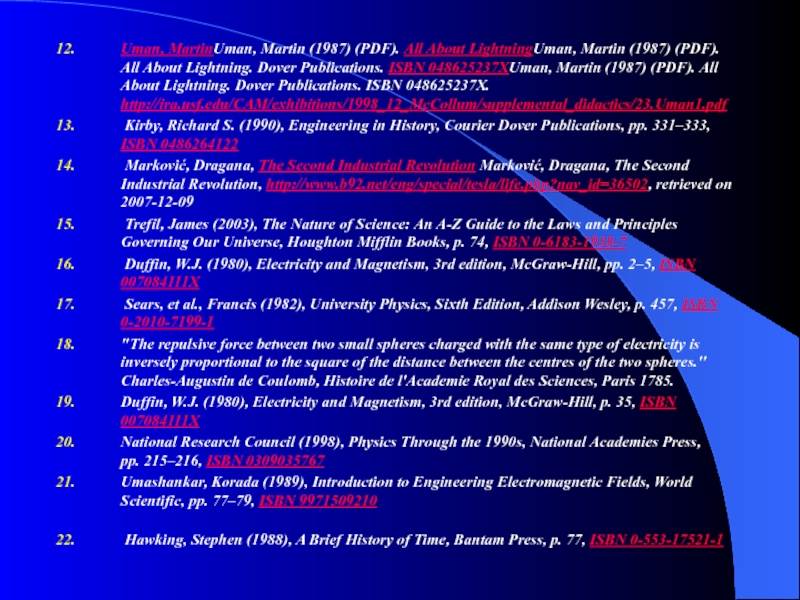
Слайд 423. Shectman, Jonathan (2003), Groundbreaking Scientific Experiments,
Inventions, and Discoveries of the 18th Century, Greenwood Press, pp. 87–91, ISBN 0-3133-2015-2
24. Sewell, Tyson (1902), The Elements of Electrical Engineering, Lockwood, p. 18. The Q originally stood for 'quantity of electricity', the term 'electricity' now more commonly expressed as 'charge'.
Close, Frank (2007), The New Cosmic Onion: Quarks and the Nature of the Universe, CRC Press, p. 51, ISBN 1-5848-8798-2
Ward, Robert (1960), Introduction to Electrical Engineering, Prentice-Hall, p. 18
Solymar, L. (1984), Lectures on electromagnetic theory, Oxford University Press, p. 140, ISBN 0-19-856169-5
Duffin, W.J. (1980), Electricity and Magnetism, 3rd edition, McGraw-Hill, pp. 23–24, ISBN 007084111X
Berkson, William (1974), Fields of Force: The Development of a World View from Faraday to Einstein, Routledge, p. 370, ISBN 0-7100-7626-6 Accounts differ as to whether this was before, during, or after a lecture.
Bird, John (2007), Electrical and Electronic Principles and Technology, 3rd edition, Newnes, p. 11, ISBN 0-978-8556-6
Bird, John (2007), Electrical and Electronic Principles and Technology, 3rd edition, Newnes, pp. 206–207, ISBN 0-978-8556-6
Bird, John (2007), Electrical and Electronic Principles and Technology, 3rd edition, Newnes, pp. 223–225, ISBN 0-978-8556-6
Sears, et al., Francis (1982), University Physics, Sixth Edition, Addison Wesley, pp. 469–470, ISBN 0-2010-7199-1
Sears, et al., Francis (1982), University Physics, Sixth Edition, Addison Wesley, p. 479, ISBN 0-2010-7199-1
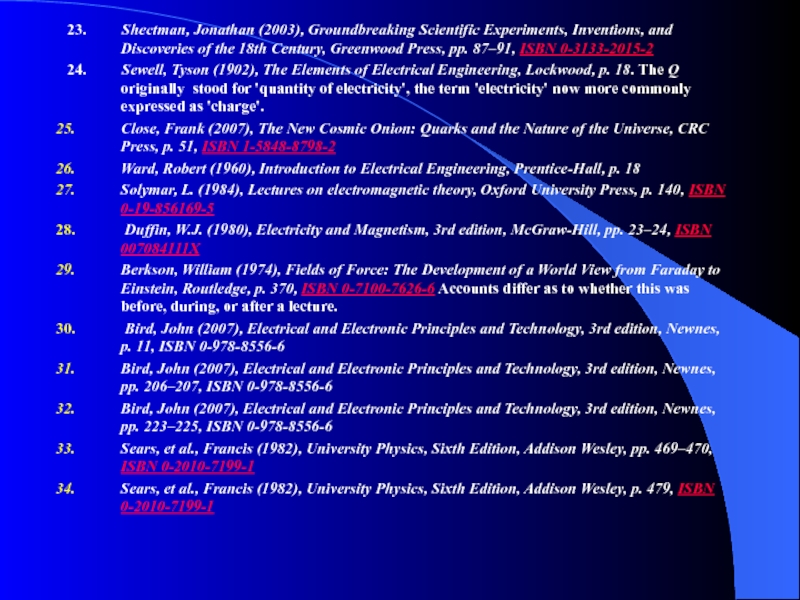
Слайд 6Electricity (from New Latin ēlectricus, "amber-like") is a general term that
encompassesElectricity (from New Latin ēlectricus, "amber-like") is a general term that encompasses a variety of phenomena resulting from the presence and flow of electric charge. These includeElectricity (from New Latin ēlectricus, "amber-like") is a general term that encompasses a variety of phenomena resulting from the presence and flow of electric charge. These include many easily recognizableElectricity (from New Latin ēlectricus, "amber-like") is a general term that encompasses a variety of phenomena resulting from the presence and flow of electric charge. These include many easily recognizable phenomena such as lightning and static electricity, but in additionElectricity (from New Latin ēlectricus, "amber-like") is a general term that encompasses a variety of phenomena resulting from the presence and flow of electric charge. These include many easily recognizable phenomena such as lightning and static electricity, but in addition, less familiarElectricity (from New Latin ēlectricus, "amber-like") is a general term that encompasses a variety of phenomena resulting from the presence and flow of electric charge. These include many easily recognizable phenomena such as lightning and static electricity, but in addition, less familiar concepts such as the electromagnetic field and electromagnetic induction.
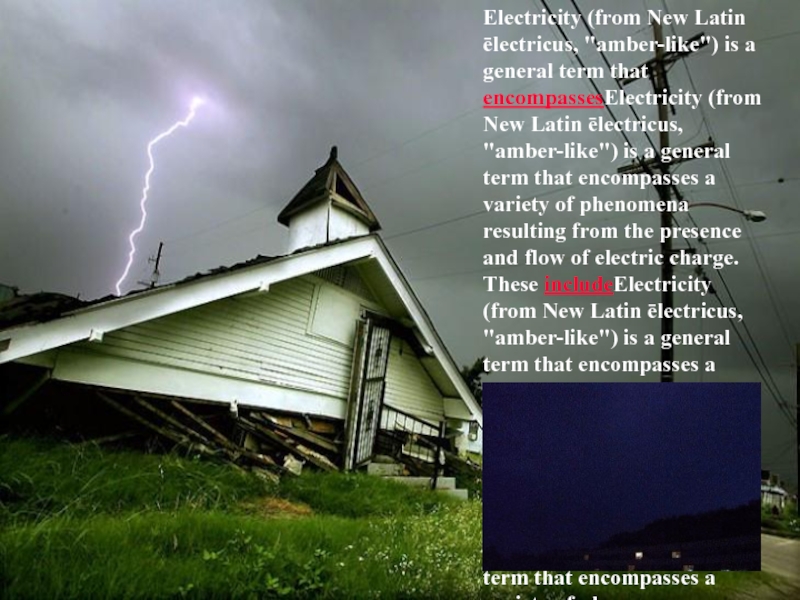
Слайд 7In general usage, the word 'electricity' is adequate to refer to
a number of physical effects. HoweverIn general usage, the word 'electricity' is adequate to refer to a number of physical effects. However, in scientific usage, the term is vagueIn general usage, the word 'electricity' is adequate to refer to a number of physical effects. However, in scientific usage, the term is vague, and these related, but distinctIn general usage, the word 'electricity' is adequate to refer to a number of physical effects. However, in scientific usage, the term is vague, and these related, but distinct, concepts are better identified by more precise terms:
Слайд 8Electric charge – a property – a property of some subatomic
– a property of some subatomic particles, which determines their electromagnetic interactions. Electrically charged matter is influenced by, and produces, electromagnetic fields
Electric current – a movement or flow of electrically charged particles, typically measured in amperes.
Electric field – an influence – an influence produced by an electric charge on other charges in its vicinity.
Electric potential – the capacity of an electric field to do work, typically measured in volts.
Electromagnetism – a fundamental interaction between the electric field and motion of electric charge.
Слайд 9Electricity has been studied since antiquity, though scientific advances Electricity has
been studied since antiquity, though scientific advances were not forthcoming until the seventeenth and eighteenth centuries. It would remain however until the late nineteenth century that engineers were able to put electricity to industrial and residentialElectricity has been studied since antiquity, though scientific advances were not forthcoming until the seventeenth and eighteenth centuries. It would remain however until the late nineteenth century that engineers were able to put electricity to industrial and residential use, a time which witnessedElectricity has been studied since antiquity, though scientific advances were not forthcoming until the seventeenth and eighteenth centuries. It would remain however until the late nineteenth century that engineers were able to put electricity to industrial and residential use, a time which witnessed a rapid expansion Electricity has been studied since antiquity, though scientific advances were not forthcoming until the seventeenth and eighteenth centuries. It would remain however until the late nineteenth century that engineers were able to put electricity to industrial and residential use, a time which witnessed a rapid expansion in the development of electrical technology.
Electricity's extraordinaryElectricity's extraordinary versatility as a source of energy means it can be put to an almost limitless set of applications which include transport, heating, lighting, communications. The backboneElectricity's extraordinary versatility as a source of energy means it can be put to an almost limitless set of applications which include transport, heating, lighting, communications. The backbone of modern industrial society is, and for the foreseeable future can be expected to remain, the use of electrical power .
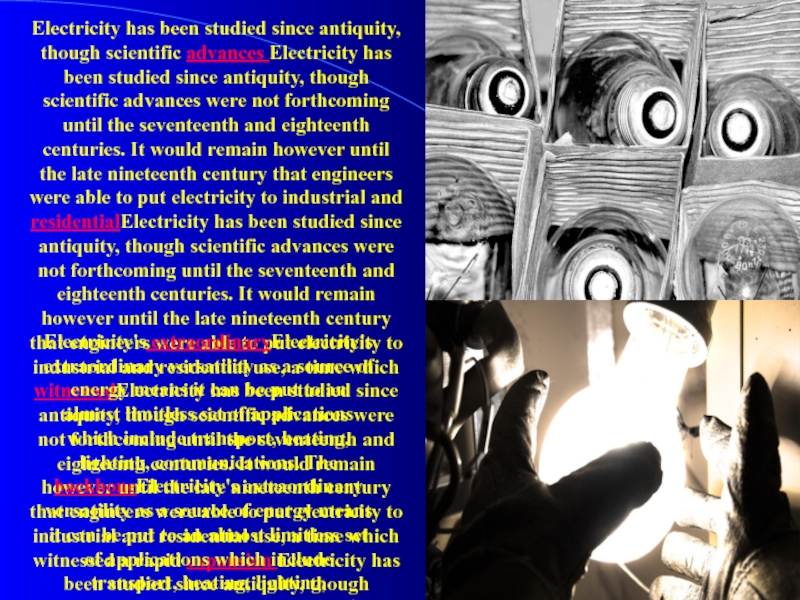
Слайд 10Benjamin Franklin conducted extensive research on electricity in the 18th century
Слайд 12
An electric circuit is an interconnectionAn electric circuit is an interconnection
of electric components, usually to perform some usefulAn electric circuit is an interconnection of electric components, usually to perform some useful task, with a return path to enable the charge to return to its source.
The componentsThe components in an electric circuit can take many forms, which can include elements such as resistors, capacitorsThe components in an electric circuit can take many forms, which can include elements such as resistors, capacitors, switches, transformers and electronics. Electronic circuits contain active components, usually semiconductors, and typically exhibit non-linear behaviour, requiring complex analysis. The simplest electric components are those that are termed passive and linear: while they may temporarily store energy, they contain no sources of it, and exhibit linear responses to stimuli.
A basic electric circuit. The voltage source V on the left drives a current I around the circuit, deliveringA basic electric circuit. The voltage source V on the left drives a current I around the circuit, delivering electrical energy into the resistance R. From the resistor, the current returns to the source, completing the circuit.
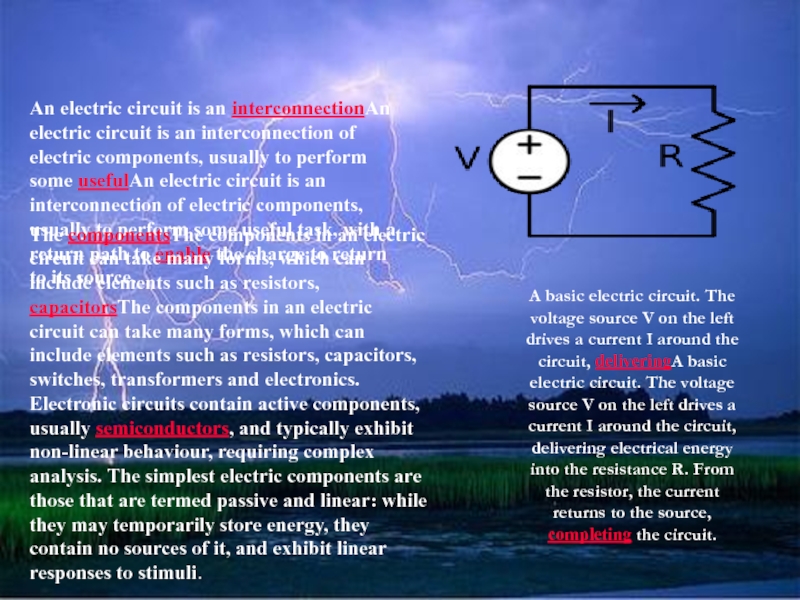
Слайд 13The capacitor is a device capableThe capacitor is a device capable
of storing charge, and thereby storing electrical energy in the resulting field. It consists of two conducting platesThe capacitor is a device capable of storing charge, and thereby storing electrical energy in the resulting field. It consists of two conducting plates separatedThe capacitor is a device capable of storing charge, and thereby storing electrical energy in the resulting field. It consists of two conducting plates separated by a thin insulating layer; in practice, thin metal foils are coiled together, increasing the surface area per unit volume and therefore the capacitance.
When the current changes, the magnetic field does too, inducing a voltage between the endsWhen the current changes, the magnetic field does too, inducing a voltage between the ends of the conductor. The inducedWhen the current changes, the magnetic field does too, inducing a voltage between the ends of the conductor. The induced voltage is proportional to the time rate of change of the current. The constant of proportionality is termed the inductance. The unit of inductance is the henry, named after Joseph Henry, a contemporaryWhen the current changes, the magnetic field does too, inducing a voltage between the ends of the conductor. The induced voltage is proportional to the time rate of change of the current. The constant of proportionality is termed the inductance. The unit of inductance is the henry, named after Joseph Henry, a contemporary of Faraday. One henry is the inductance that will induce When the current changes, the magnetic field does too, inducing a voltage between the ends of the conductor. The induced voltage is proportional to the time rate of change of the current. The constant of proportionality is termed the inductance. The unit of inductance is the henry, named after Joseph Henry, a contemporary of Faraday. One henry is the inductance that will induce a potential difference of one volt if the current through it changes at a rate of one ampere per second
The inductorThe inductor is a conductor, usually a coil of wire, that storesThe inductor is a conductor, usually a coil of wire, that stores energy in a magnetic field in response to the current flowing through it.
The unit of capacitance is the farad, named after Michael Faraday, and given the symbol F: one farad is the capacitance that developsThe unit of capacitance is the farad, named after Michael Faraday, and given the symbol F: one farad is the capacitance that develops a potential difference of one volt when it stores a charge of one coulomb.
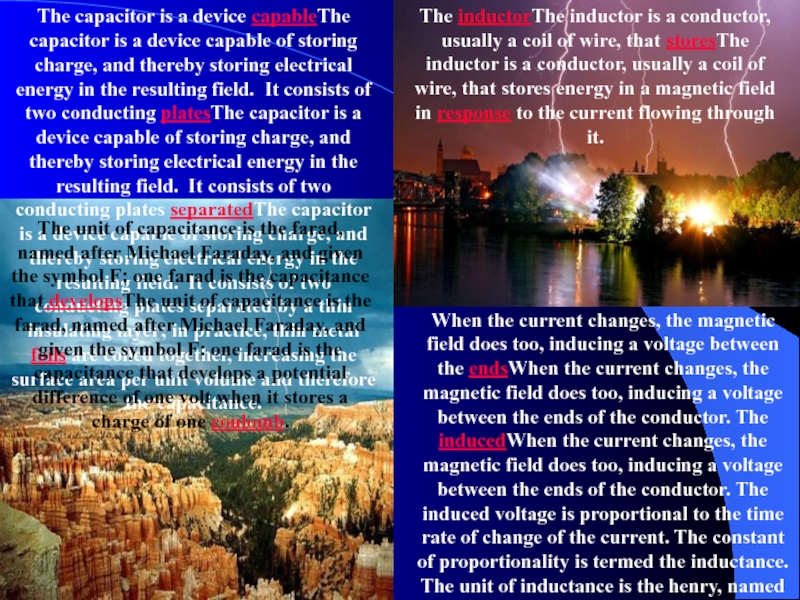
Слайд 14Electrical energy is usually generated by electro-mechanical generators driven by steam
produced from fossilElectrical energy is usually generated by electro-mechanical generators driven by steam produced from fossil fuel combustionElectrical energy is usually generated by electro-mechanical generators driven by steam produced from fossil fuel combustion, or the heat released from nuclear reactionsElectrical energy is usually generated by electro-mechanical generators driven by steam produced from fossil fuel combustion, or the heat released from nuclear reactions; or from other sources such as kinetic energy extracted from wind or flowing water. Such generators bear no resemblanceElectrical energy is usually generated by electro-mechanical generators driven by steam produced from fossil fuel combustion, or the heat released from nuclear reactions; or from other sources such as kinetic energy extracted from wind or flowing water. Such generators bear no resemblance to Faraday's homopolar disc generator of 1831, but they still rely on his electromagnetic principle that a conductor linking Electrical energy is usually generated by electro-mechanical generators driven by steam produced from fossil fuel combustion, or the heat released from nuclear reactions; or from other sources such as kinetic energy extracted from wind or flowing water. Such generators bear no resemblance to Faraday's homopolar disc generator of 1831, but they still rely on his electromagnetic principle that a conductor linking a changing magnetic field induces a potential difference acrossElectrical energy is usually generated by electro-mechanical generators driven by steam produced from fossil fuel combustion, or the heat released from nuclear reactions; or from other sources such as kinetic energy extracted from wind or flowing water. Such generators bear no resemblance to Faraday's homopolar disc generator of 1831, but they still rely on his electromagnetic principle that a conductor linking a changing magnetic field induces a potential difference across its ends. The inventionElectrical energy is usually generated by electro-mechanical generators driven by steam produced from fossil fuel combustion, or the heat released from nuclear reactions; or from other sources such as kinetic energy extracted from wind or flowing water. Such generators bear no resemblance to Faraday's homopolar disc generator of 1831, but they still rely on his electromagnetic principle that a conductor linking a changing magnetic field induces a potential difference across its ends. The invention in the late nineteenth century of the transformer meant that electricity could be generated at centralizedElectrical energy is usually generated by electro-mechanical generators driven by steam produced from fossil fuel combustion, or the heat released from nuclear reactions; or from other sources such as kinetic energy extracted from wind or flowing water. Such generators bear no resemblance to Faraday's homopolar disc generator of 1831, but they still rely on his electromagnetic principle that a conductor linking a changing magnetic field induces a potential difference across its ends. The invention in the late nineteenth century of the transformer meant that electricity could be generated at centralized power stations, benefitingElectrical energy is usually generated by electro-mechanical generators driven by steam produced from fossil fuel combustion, or the heat released from nuclear reactions; or from other sources such as kinetic energy extracted from wind or flowing water. Such generators bear no resemblance to Faraday's homopolar disc generator of 1831, but they still rely on his electromagnetic principle that a conductor linking a changing magnetic field induces a potential difference across its ends. The invention in the late nineteenth century of the transformer meant that electricity could be generated at centralized power stations, benefiting from economies of scaleElectrical energy is usually generated by electro-mechanical generators driven by steam produced from fossil fuel combustion, or the heat released from nuclear reactions; or from other sources such as kinetic energy extracted from wind or flowing water. Such generators bear no resemblance to Faraday's homopolar disc generator of 1831, but they still rely on his electromagnetic principle that a conductor linking a changing magnetic field induces a potential difference across its ends. The invention in the late nineteenth century of the transformer meant that electricity could be generated at centralized power stations, benefiting from economies of scale, and be transmitted across countries with increasing efficiencyElectrical energy is usually generated by electro-mechanical generators driven by steam produced from fossil fuel combustion, or the heat released from nuclear reactions; or from other sources such as kinetic energy extracted from wind or flowing water. Such generators bear no resemblance to Faraday's homopolar disc generator of 1831, but they still rely on his electromagnetic principle that a conductor linking a changing magnetic field induces a potential difference across its ends. The invention in the late nineteenth century of the transformer meant that electricity could be generated at centralized power stations, benefiting from economies of scale, and be transmitted across countries with increasing efficiency. Since electrical energy cannotElectrical energy is usually generated by electro-mechanical generators driven by steam produced from fossil fuel combustion, or the heat released from nuclear reactions; or from other sources such as kinetic energy extracted from wind or flowing water. Such generators bear no resemblance to Faraday's homopolar disc generator of 1831, but they still rely on his electromagnetic principle that a conductor linking a changing magnetic field induces a potential difference across its ends. The invention in the late nineteenth century of the transformer meant that electricity could be generated at centralized power stations, benefiting from economies of scale, and be transmitted across countries with increasing efficiency. Since electrical energy cannot easily be stored in quantities large enough to meet demandsElectrical energy is usually generated by electro-mechanical generators driven by steam produced from fossil fuel combustion, or the heat released from nuclear reactions; or from other sources such as kinetic energy extracted from wind or flowing water. Such generators bear no resemblance to Faraday's homopolar disc generator of 1831, but they still rely on his electromagnetic principle that a conductor linking a changing magnetic field induces a potential difference across its ends. The invention in the late nineteenth century of the transformer meant that electricity could be generated at centralized power stations, benefiting from economies of scale, and be transmitted across countries with increasing efficiency. Since electrical energy cannot easily be stored in quantities large enough to meet demands on a national scale, at all times exactly as much must be produced as is required. This requiresElectrical energy is usually generated by electro-mechanical generators driven by steam produced from fossil fuel combustion, or the heat released from nuclear reactions; or from other sources such as kinetic energy extracted from wind or flowing water. Such generators bear no resemblance to Faraday's homopolar disc generator of 1831, but they still rely on his electromagnetic principle that a conductor linking a changing magnetic field induces a potential difference across its ends. The invention in the late nineteenth century of the transformer meant that electricity could be generated at centralized power stations, benefiting from economies of scale, and be transmitted across countries with increasing efficiency. Since electrical energy cannot easily be stored in quantities large enough to meet demands on a national scale, at all times exactly as much must be produced as is required. This requires electricity utilitiesElectrical energy is usually generated by electro-mechanical generators driven by steam produced from fossil fuel combustion, or the heat released from nuclear reactions; or from other sources such as kinetic energy extracted from wind or flowing water. Such generators bear no resemblance to Faraday's homopolar disc generator of 1831, but they still rely on his electromagnetic principle that a conductor linking a changing magnetic field induces a potential difference across its ends. The invention in the late nineteenth century of the transformer meant that electricity could be generated at centralized power stations, benefiting from economies of scale, and be transmitted across countries with increasing efficiency. Since electrical energy cannot easily be stored in quantities large enough to meet demands on a national scale, at all times exactly as much must be produced as is required. This requires electricity utilities to make carefulElectrical energy is usually generated by electro-mechanical generators driven by steam produced from fossil fuel combustion, or the heat released from nuclear reactions; or from other sources such as kinetic energy extracted from wind or flowing water. Such generators bear no resemblance to Faraday's homopolar disc generator of 1831, but they still rely on his electromagnetic principle that a conductor linking a changing magnetic field induces a potential difference across its ends. The invention in the late nineteenth century of the transformer meant that electricity could be generated at centralized power stations, benefiting from economies of scale, and be transmitted across countries with increasing efficiency. Since electrical energy cannot easily be stored in quantities large enough to meet demands on a national scale, at all times exactly as much must be produced as is required. This requires electricity utilities to make careful predictions of their electrical loads, and maintain constant coordination with their power stations.
Production and uses
Generation
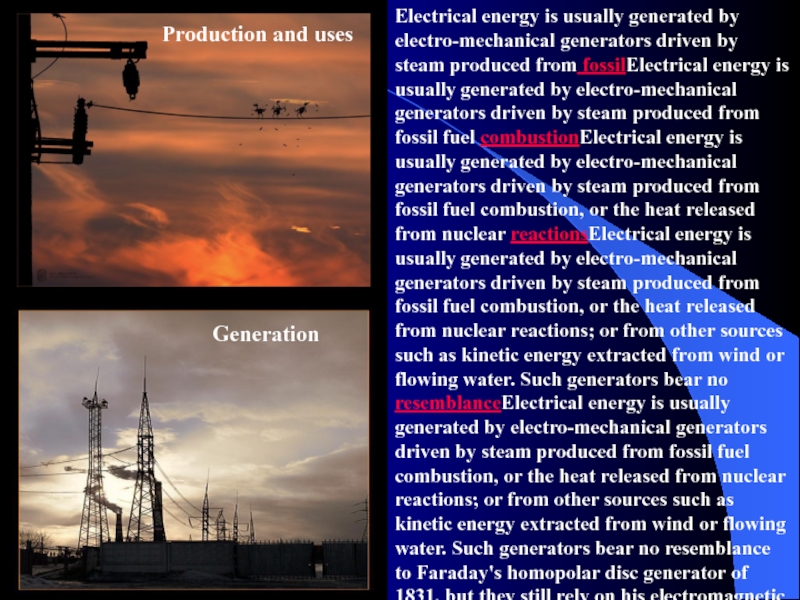
Слайд 15DemandDemand for electricity grows with great rapidity Demand for electricity grows
with great rapidity as a nation modernizes and its economy develops. The United States showed a 12% increaseDemand for electricity grows with great rapidity as a nation modernizes and its economy develops. The United States showed a 12% increase in demand during each year of the first three decades of the twentieth century, a rate of growth that is now being experienced by emerging emerging economies such as those of India or China. Historically, the growthDemand for electricity grows with great rapidity as a nation modernizes and its economy develops. The United States showed a 12% increase in demand during each year of the first three decades of the twentieth century, a rate of growth that is now being experienced by emerging emerging economies such as those of India or China. Historically, the growth rate for electricity demand has outstripped that for other forms of energy, such as coal.
Слайд 17Electricity is an extremely flexibleElectricity is an extremely flexible form of
energy, and it may be adapted to a huge, and growingElectricity is an extremely flexible form of energy, and it may be adapted to a huge, and growing, number of uses. The invention of a practical incandescentElectricity is an extremely flexible form of energy, and it may be adapted to a huge, and growing, number of uses. The invention of a practical incandescent light bulb in the 1870s led to lighting becoming one of the first publicly availableElectricity is an extremely flexible form of energy, and it may be adapted to a huge, and growing, number of uses. The invention of a practical incandescent light bulb in the 1870s led to lighting becoming one of the first publicly available applicationsElectricity is an extremely flexible form of energy, and it may be adapted to a huge, and growing, number of uses. The invention of a practical incandescent light bulb in the 1870s led to lighting becoming one of the first publicly available applications of electrical power. Although electrification broughtElectricity is an extremely flexible form of energy, and it may be adapted to a huge, and growing, number of uses. The invention of a practical incandescent light bulb in the 1870s led to lighting becoming one of the first publicly available applications of electrical power. Although electrification brought with it its own dangers, replacingElectricity is an extremely flexible form of energy, and it may be adapted to a huge, and growing, number of uses. The invention of a practical incandescent light bulb in the 1870s led to lighting becoming one of the first publicly available applications of electrical power. Although electrification brought with it its own dangers, replacing the naked flames of gas lighting greatly reduced fire hazards within homes and factories. Public utilities were set up in many cities targeting the burgeoning market for electrical lighting.
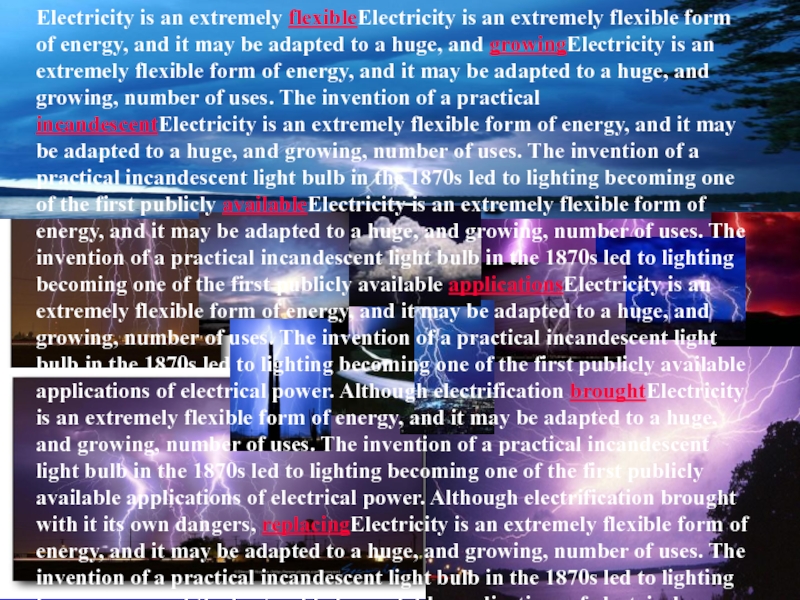
Слайд 18Electricity is used withinElectricity is used within telecommunications, and indeedElectricity is
used within telecommunications, and indeed the electrical telegraph, demonstrated commercially in 1837 by Cooke and Wheatstone, was one of its earliest applications. With the construction of first intercontinentalElectricity is used within telecommunications, and indeed the electrical telegraph, demonstrated commercially in 1837 by Cooke and Wheatstone, was one of its earliest applications. With the construction of first intercontinental, and then transatlantic, telegraph systems in the 1860s, electricity had enabled communications in minutes across the globe.
Слайд 19Optical fibre and satelliteOptical fibre and satellite communication technology have taken
Optical fibre and satellite communication technology have taken a share of the market for communications systems, but electricity can be expected to remain an essential part of the process.
Слайд 20Electricity and the natural world
Physiological effects
Слайд 21A voltage applied to a human body causes an electric current
to flow through the tissuesA voltage applied to a human body causes an electric current to flow through the tissues, and although the relationshipA voltage applied to a human body causes an electric current to flow through the tissues, and although the relationship is non-linear, the greater the voltage, the greater the current. The threshold for perception varies with the supply frequency and with the path of the current, but is about 1 mA for mains-frequency electricity.
If the current is sufficientlyIf the current is sufficiently high, it will cause muscles contractionIf the current is sufficiently high, it will cause muscles contraction, fibrillation of the heart, and tissue burnsIf the current is sufficiently high, it will cause muscles contraction, fibrillation of the heart, and tissue burns. The lack of any visible sign that a conductor is electrified makes electricity a particularIf the current is sufficiently high, it will cause muscles contraction, fibrillation of the heart, and tissue burns. The lack of any visible sign that a conductor is electrified makes electricity a particular hazard.
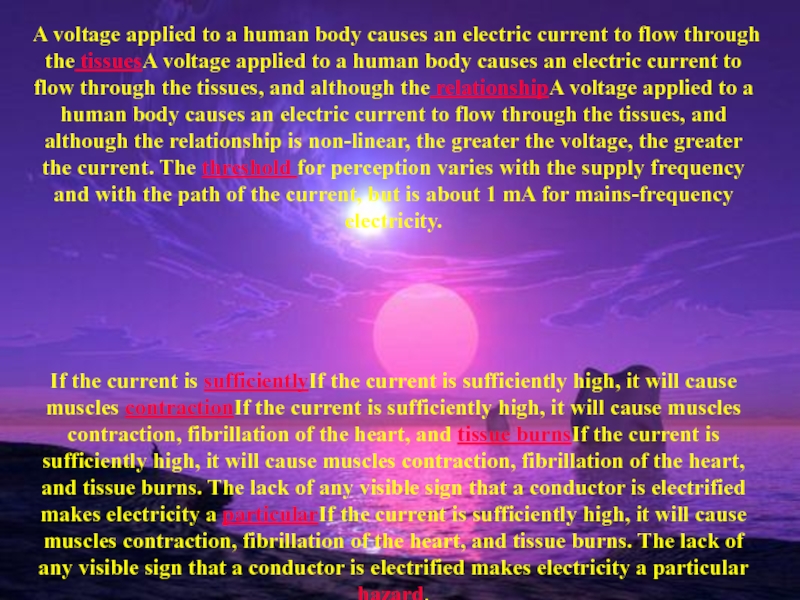
Слайд 22The painThe pain caused by an electric shockThe pain caused by
an electric shock can be intense, leading electricity at times to be employed as a method of torture. Death caused by an electric shock is referred to as electrocution.
Electrocution is still Electrocution is still the means of judicial executionElectrocution is still the means of judicial execution in some jurisdictions, though its use has become in recent times.




